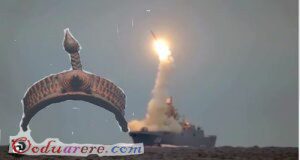Eastern Ghouta, Yarmouk Area, Eastern Qalamoun, Rastan Pocket
By the late winter of 2018, the Russian military operation in Syria entered its fourth stage. At this stage, the Syrian military had to deal with the remaining militant-held pockets within the majority government-held areas and to keep security and order in the recently liberated areas, especially the city of Deir Ezzor and in the Euphrates Valley.
A military operation against Hayat Tahrir al-Sham, Jaish al-Islam, Ahrar al-Sham and Faylaq al-Rahman in the Eastern Ghouta region of Damascus, code-named Operation Damascus Steel, took place in the period from February 18, 2018 to April 14, 2018. The operation involved about 25,000 fighters from the SAA, the Tiger Forces, the Republican Guard, Liwa al-Quds, the NDF, the 4th Armored Division, the 5th Assault Corps and other pro-government factions. This force, backed by Russian Special Operations Forces troops, faced about 15,000-18,000 members of local militant groups. Government troops split the militant-held pocket into two separate parts and then cleared the two newly formed pockets one after another. As in many previous cases, local reconciliation agreements played an important part of the success of the operation.
The operation was not undermined by the alleged chemical attack in the town of Douma, which took place on April 7, nor the missile strike on Syrian government targets by the US, the UK and France carried out on April 14. The US led missile strikes exerted no real military or political pressure on the Syrian government, nor their allies engaged in the operation to finally retake the East Ghouta suburb of Damascus. The assertions by the U.S. and its allies on the floor of the UN assembly that claimed that the Syrian government had perpetrated a poison gas attack on Douma proved inconclusive, if not totally improbable.
During the clashes, about 550 militants were killed and about 1,200 members of militant groups surrendered to the SAA. According to pro-militant sources, government forces lost up to 600 fighters. The mainstream media and pro-militant outlets also claimed that “thousands” of civilians died during the operation, but this number has never been verified.
An operation against ISIS in the Yarmouk refugee camp area in southern Damascus was carried out between April 19 and May 21. Palestinian pro-government militias, like Liwa al-Quds and the Popular Front for the Liberation of Palestine – General Command, played a significant role in the operation. The Syrian military forced members of non-ISIS militant groups to accept a reconciliation deal, thus securing the area east of Yarmouk, and carried out a large-scale multipronged advance on ISIS positions. ISIS members in the area were lacking in military equipment, supplies and anti-armor capabilities. By the end of May, the entire southern Damascus area had been secured. According to Russian, Syrian and Iranian state-run media, all ISIS members had been eliminated. Nonetheless, sources on the ground have stated that at least some ISIS members and their families – about 1,600 persons, were allowed to withdraw from the area via an opened corridor after they had surrendered all heavy weapons in their possession.
Two more victories were achieved by the Syrian-Iranian-Russian alliance in eastern Qalamoun and the area of Rastan:
- Militants in Rastan accepted a surrender agreement on May 2, surrendering their weapons and leaving the area by May 16. About 11,000 members of militant groups and their families left Rastan and nearby settlements and relocated to the militant-held parts of Idlib and Aleppo provinces via an open corridor.
- On April 17, militant groups accepted a surrender agreement in eastern Qalamoun. Under the agreement militants surrendered their weapons and were granted the opportunity to leave the area or to settle their legal status. The Syrian military restored full control over the area on April 25. It is important to note that eastern Qalamoun militants surrendered a large number of heavy military equipment, including battle tanks, anti-tank guided missiles, rocket launchers and other weapons. Using such a large arsenal they may have been able to resist the SAA advance for a notable amount of time. When weighing their options with full knowledge of the many recent SAA victories over the past year, they chose to surrender.
By June 2018, the SAA and its allies had liberated a large part of the country, including the cities of Aleppo and Deir Ezzor, the entire countryside of Damascus, and had liquidated the many pockets of opposition that had existed in the government-held portion of the country. ISIS’ self-proclaimed Caliphate in Syria had been taken apart in a series well planned and decisively executed military campaigns.
On June 18, the SAA and its allies launched a military operation to clear southern Syria of both ISIS and Hayat Tahrir al-Sham, and to re-establish control of the Syrian-Jordanian border. Previously, Damascus, assisted by Russian advisers, made a number of attempts to implement a reconciliation agreement in the area allowing members of relatively moderate opposition groups to surrender their weapons and settle their legal status. All these attempts were sabotaged by Hayat Tahrir al-Sham and its supporters. Thus, a military solution was implemented. Within the next month, the SAA liberated the entire Daraa countryside and set conditions to combat ISIS east of the Golan Heights.
From July 21 to July 31, the SAA also cleared the ISIS-held pocket east of the Golan Heights. However, the security situation in the area still remains complicated and additional security measures are needed to prevent terrorist attacks there.
When the southern Syria issue is finally resolved, the SAA and its allies will turn their gaze upon the province of Idlib. Turkey, which has recently increased both its influence and presence there, has no justification for attempting to preserve Hayat Tahrir al-Sham or any of its many affiliated militant groups in the face of Syrian military intervention. The Erdogan government will have to find a way to either reconcile and divorce itself from the internationally recognized terrorist group, or somehow continue maintaining a relationship with it, while honoring the framework of the agreements reached by Syria, Turkey, Russia and Iran in the Astana format. The answer to this question will become more apparent only when the SAA begin military operations against militants in Idlib sometime in the near future.
Results of the military operation
The Russian Defense Ministry provided a comprehensive report on the results of its military operation in Syria in late 2017. The report stated that by November 7, 2017, 54,000 members of militant groups, 394 battle tanks and over 12,000 pieces of weaponry, vehicles and other equipment had been eliminated in Syria. An estimated 4,200 of the eliminated militants were from Russia or countries bordering it. During that same period, warplanes of the Russian Aerospace Forces carried out over 30,000 combat sorties, and executed 92,000 airstrikes. This amounted to an average of 100 combat sorties and 250 airstrikes on a daily basis. Attack helicopters carried out a total of approximately 7,000 combat sorties.
Warplanes from the Admiral Kuznetsov carried out 420 combat sorties, 117 of them at night, hitting 1,252 targets. The Russian Navy carried out ten missile strikes on militant targets, employing at least 70 Kalibr cruise missiles. The first combat usage of Kalibr missiles in Syria was on October 7, 2015, only a week after the start of the military operations within the war-torn country.
Russian sappers deployed in the country removed over 100,000 mines and IEDs and continue to operate across the country. They have employed the Uran-6 mine-clearing robotic systems, OKO-2 ground-penetrating system and other modern equipment. To date, about 1,000 Syrian sappers have been trained by their Russian counterparts and the training program is ongoing.
Russia has played an important role in the logistics and maintenance support of the SAA, both in general and on an operational level. According to the Defense Ministry, Russian specialists are actively involved in assisting the Syrian military in maintaining and recovering military equipment. While most of this activity remains unpublicized, it’s known that in 2015 the Russians restored a tank-repairing plant in the city of Homs. The plant is currently operated by the Syrian government.
Additionally, Russian specialists and officers contributed to the improvement of Syria’s air defense capabilities, while providing both maintenance support to air defense systems and radars and training to Syrian officers. In April 2018, the Russian state-run news agency RIA Novosti reported, citing a source in the Russia Defense Ministry, that Russia had delivered at least 40 Pantsir-S1 short to medium range defense systems to Syria over the past few years.
In the period from late September 2015 to August 2017, Russian specialists carried out over 3,000 ordinary maintenance activities and over 25,000 activities linked to maintenance of Russian weapons and equipment deployed in Syria. Additionally, the Russian military tested over 600 types of weapons and equipment, including MiG-29SMT air superiority fighters, Su-57 fifth-generation fighter jets and BMPT-72 Terminator tank support combat vehicles.
Two Su-57 fighter jets passed combat tests in Syria in February 2018. According to the defense ministry, one of the jets used advanced air-launched cruise missiles against militant targets.
On December 22, 2017, Russian Defense Minister Sergei Shoigu said that a total of 48,000 Russian service members took part in the Syria military campaign. He added that 14,000 of these service members received state awards.
Casualties and material loses of the Russian military
From the start of the military operation on September 30, 2015 through June 20, 2018, the Russian military lost 93 servicemen in combat and non-combat incidents. Of these, 39 of them died on March 6, 2018 when an An-26 transport aircraft crashed near Khmeimim Air Base, because of a supposed technical malfunction. Combat related deaths claimed the lives of 43 Russian servicemen and specialists.
A total of 14 aircraft, excluding UAVs, were lost by the Russian military according to official sources. This number includes:
Separately, it should be noted that 92 people died in a crash of a Russian Defense Ministry Tupolev Tu-154, which was heading from the city of Sochi to Khmeimim airbase. The plane crashed into the Black Sea on December 25, 2016. The passenger list included 64 members of the Alexandrov Ensemble choir, 8 crew members, 7 soldiers, 9 journalists, the Director of the Department of Culture for the Russian Ministry of Defense and three civilians.
Comparing Russian losses to that of the US Air Force and US Navy in operations in Syria, Iraq and Afghanistan, it is easy to conclude that Russia suffered higher losses in aircraft during the same period. One reason for the imbalance is that Russia is behind the US in UAV technologies and does not operate unmanned combat aerial vehicles. The primary reason must be attributed to the difference between the approaches implemented by the Russian Aerospace Forces and the US Air Force. The US has either engaged ground targets from a high altitude while using guided munitions, or via unmanned armed UAVs. By contrast, although Russian combat aviation conducted many airstrikes from high altitude via guided munitions, the majority of airstrikes by Russian aircraft were conducted at low altitude. Russian use of traditional close air support, where combat aviators work in close communication with forward air observers embedded with units on the front line, or even behind enemy lines, while attacking at low altitude resulted in a higher probability of aircraft loss, but resulted in higher target accuracy and better results. The heavy use of attack helicopters in the CAS role by the Russian Aerospace Forces proved greatly effective in providing accurate and lethal air support to allied units engaged in combat in both open terrain and urban areas.
There is no confirmed data on casualties among Russian and Russia-linked PMCs. If one believes in all of the speculations spread by the mainstream media and monitoring groups, this number should be not less than 1,000-1,500 dead and wounded. The problem is that reasonably substantiated reports, which include at a minimum the name, date or location of death of individuals engaged in such employment, exist only for about 30 individuals. According to most military analysts, the real number of Russian PMC casualties is closer to two or three hundred.
Chemical weapons and missile strikes
Additionally, it is important to discuss the alleged use of chemical weapons in the conflict and the actions of the US-led bloc in response, using these attacks as justification for overt military action. There were two widely covered cases of alleged chemical weapons usage over the past 3 years:
- Khan Shaykhun
- Douma
An alleged chemical attack in Khan Shaykhun, Idlib province, took place on April 4, 2017. The incident occurred in the militant-held area, deep behind the frontline, amid a rapidly developing and successful operation conducted by the SAA against Hayat Tahrir al-Sham in northern Hama. According to pro-militant sources, mostly the Western-backed militant-linked organization known as the White Helmets, at least 74 people were killed and over 550 were injured. The White Helmets and others claimed that chemical weapons were dropped by a warplane of the Syrian Air Force. The US, UK, France, Israel and a number of other countries immediately accused the Syrian government of being responsible for the attack. The Syrian government, Russia and Iran described the attack as a staged provocation and called on the international community to carry out an independent and transparent investigation of the incident.
On April 7, ahead of any investigation, the USS Porter guided missile destroyer launched 59 Tomahawk cruise missiles at the Syrian Air Force’s Shayrat Air Base in the province of Homs. According to the US Central Command, the missiles “targeted aircraft, hardened aircraft shelters, petroleum and logistical storage, ammunition supply bunkers, air defense systems, and radars”. US Secretary of Defense James Mattis said that the strike had resulted, “in the damage or destruction of fuel and ammunition sites, air defense capabilities, and 20 percent of Syria’s operational aircraft. The Syrian government has lost the ability to refuel or rearm aircraft at Shayrat airfield and at this point, use of the runway is of idle military interest.”
Syrian warplanes resumed their operations from the airbase a few hours after the US strike. The Russian Defense Ministry described the “combat effectiveness” of the attack as “extremely low” adding that only 23 missiles hit their intended targets. According to existing visual evidence, 10 Syrian aircraft were destroyed: three Su-22, four Su-22M3, and three MiG-23ML. According to some sources, the number of targeted aircraft could be up to 15; however, sources at the airbase have said that most of the destroyed aircraft had been already damaged or out of service.
According to Pentagon spokesman Captain Jeff Davis, “Russian forces were notified in advance of the strike using the established deconfliction line”. There is no doubt that Moscow informed the Syrians who had withdrawn most of their assets from Shayrat Air Base prior to the strike. This could explain why no real damage was incurred from the strike. International investigators have never visited Khan Shaykhun nor Shayrat Air Base.
A year after the Shayrat missile strike, on April 7, 2018 an alleged chemical attack took place in Douma, in the Damascus suburb of Eastern Ghouta. The incident allegedly occurred in the militant-held area, behind the frontline, amid a rapidly successful operation of the SAA against Hayat Tahrir al-Sham, Jaish al-Islam, Ahrar al-Sham and Faylaq al-Rahman. By April 7, the SAA had liberated most of the area and had already forced Jaish al-Islam, which had controlled Douma, to accept a surrender agreement.
The White Helmets once again became the main source of the information on the alleged casualties. According to pro-militant sources, from 48 to 85 people were killed and over 500 were injured in the alleged attack. They claimed that a helicopter of the Syrian Air Force had dropped chemical weapons. The US, United Kingdom, France, Israel and a number of their usual allies immediately accused the Syrian government of being responsible for the attack. Once again, the Syrian government, Russia and Iran described the attack as a staged provocation and called on the international community to carry out an independent and transparent investigation of the incident.
On April 14, ahead of any investigation, the US, the UK and France carried out coordinated missile strikes on government targets in Syria. US Secretary of Defense James Mattis said that this attack was a “decisive action to strike the Syrian chemical weapons infrastructure”. According to the Pentagon, the US, the UK and France launched 105 missiles at the alleged “chemical weapons” facilities of the Assad government:
- 66 Tomahawk cruise missiles;
- 20 Storm Shadow/SCALP EG air-launched cruise missiles;
- 19 AGM-158 JASSM air-launched cruise missiles.
The Pentagon alleged that all the missiles hit their targets:
- 76 missiles hit “Barzah Research and Development Center”;
- 22 missiles hit “Him Shinshar Chemical Weapons Storage Site”;
- 7 missiles hit “Him Shinshar CW Bunker”.
According to data provided by the Russian Defense Ministry:
- 22 US, French, British missiles hit their targets;
- 46 missiles were intercepted by Syrian air defense systems covering the capital of Syria and the nearby airfields at Duvali, Dumayr, Blai, and Mazzeh;
- 20 missiles were intercepted in three areas within the zone of responsibility of Syrian air defenses of Homs;
- a number of missiles failed to reach their targets due to apparent technical reasons.
The Russians also revealed wreckage of the intercepted missiles and displayed at least one unexploded Tomahawk cruise missile. The ministry of defense added that two unexploded missiles (a Tomahawk and a high-accuracy air-launched missile) had been recovered and delivered to Russia from Syria. Russia also carried out its own investigation of the alleged chemical attack in Douma and stated that its results showed that the attack was a staged provocation. Russian specialists also found and interviewed people, doctors and alleged victims filmed by the White Helmets in a video allegedly showing the aftermath of the chemical attack.
On April 27, Russian and Syrian officials as well as witnesses of the alleged chemical attack participated in a press conference in The Hague. The event was entitled “Presentation by the representative of the Ministry of Defense of the Russian Federation with direct participants of the fake video produced by ‘White Helmets’ on 7th April 2018, in the Hospital of Douma”. The data provided during the press conference debunked the Western-backed version of the events. Russia brought 17 witnesses of the incident, as well as Douma hospital staff members to The Hague. OPCW technical experts interviewed only 6 of 17 witnesses.
Both the Khan Shaykhun and Douma incidents developed via similar scenarios with the US-led coalition carrying out cruise missile strikes on the basis of claims from militants without conducting any investigation. In the both cases the actual effectiveness of the US-led missile strikes were much less than the Pentagon had claimed. Some assert that both military actions appeared to be more of a PR campaign conducted by the Trump administration meant to make the president appear tough on Russia.
Other military experts link the high rate of missile intercept and technical failure to assistance provided by the Russian military deployed in Syria. While air defense systems of the Russian military group in Syria were not employed directly, Russian air defense forces likely provided the Syrian military with vital operational data and targeted the incoming missiles with their own electronic warfare capabilities.
 Ọmọ Oòduà Naija Gist | News From Nigeria | Entertainment gist Nigeria|Networking|News.. Visit for Nigeria breaking news , Nigerian Movies , Naija music , Jobs In Nigeria , Naija News , Nollywood, Gist and more
Ọmọ Oòduà Naija Gist | News From Nigeria | Entertainment gist Nigeria|Networking|News.. Visit for Nigeria breaking news , Nigerian Movies , Naija music , Jobs In Nigeria , Naija News , Nollywood, Gist and more








